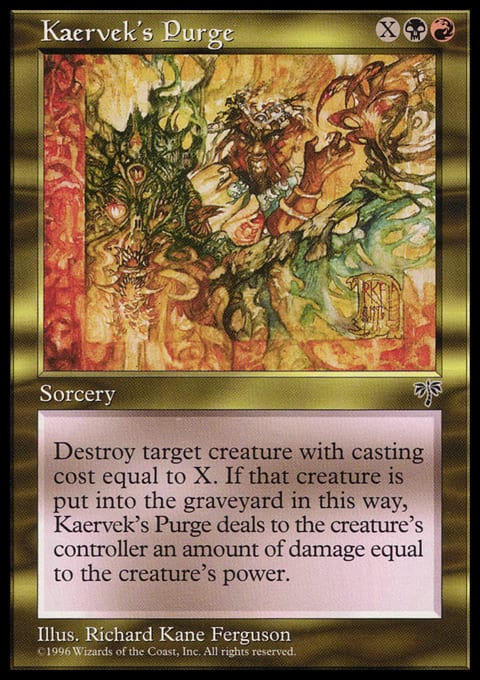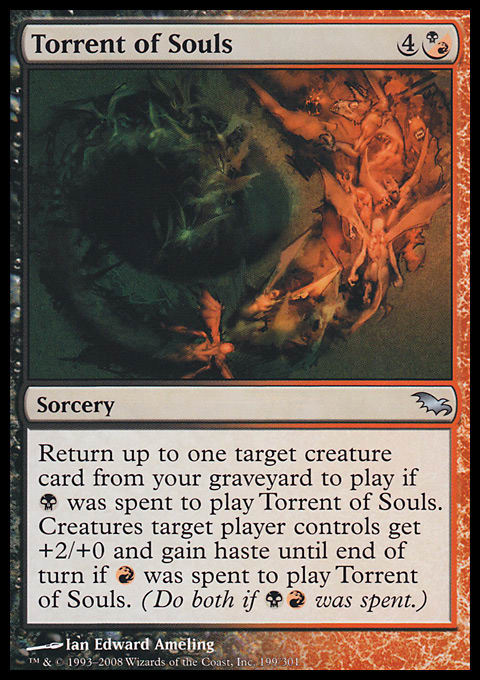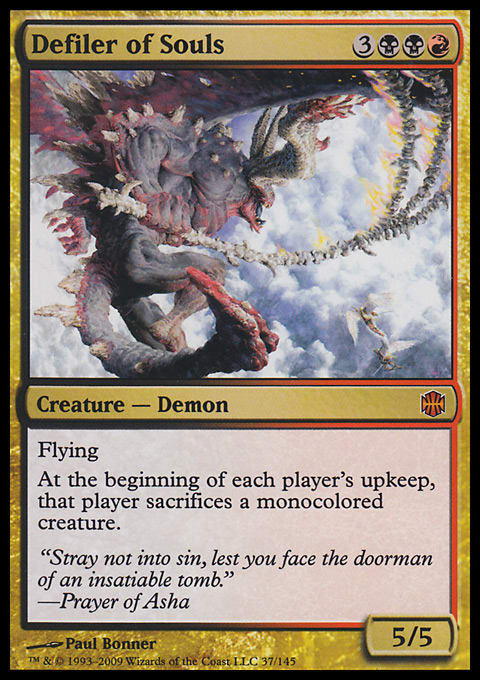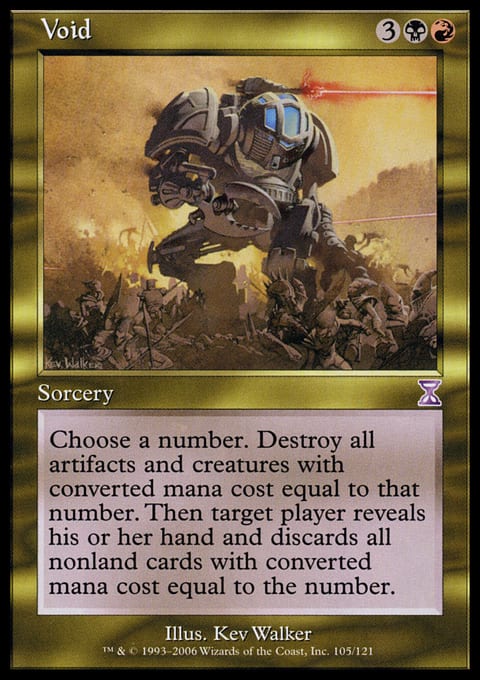It’s no secret that I love black, and red is probably my second- or third-favorite color, but last time we visited Ravnica, Rakdos completely failed to capture my interest. Partly, it was because the signature mechanic, hellbent, was the most high-risk-low-reward mechanic in the history of ever,1 and partly because the flavor of mindless nihilistic glee never appealed to me. That being said, this color combination can be a lot of fun, and it has more pure destructive power than perhaps any other guild.
Strengths
Rakdos is the color pair of mindless aggression: It has a passion for hurting everyone, throwing away resources for immediate gain, and blowing shit up. If you like massive haymakers and short games, Rakdos is the guild for you.
Doubling Down
Unlike Azorius, black and red don’t so much cover each other’s weaknesses as accentuate their strengths. Neither color can deal with enchantments, and both have a tendency to sacrifice their resource base in order to bring the big beats. Still, red does give black access to some of the best artifact removal in the game, and black can help red with its unfortunate tendency to live off the top with an empty hand. Also, the single-mindedness of Rakdos means that even its crappiest cards are focused on bringing your opponents down to 0. Here are the things that Rakdos does best.
Blood
Big surprise: Rakdos is really good at killing stuff, which may sound one-dimensional, but that can facilitate both aggro and control/combo strategies. While black has always excelled at dealing death, access to instant-speed sweepers like Inferno and Fault Line, as well as the wonderful but underplayed Blasphemous Act, can enhance black’s arsenal, while red can benefit from targeted removal like Hex and Dregs of Sorrow.
Strategically, of course, knowing that you can kill anyone’s creatures makes it very easy to assess threats: The player most likely to win without creatures should always be at the top of your hit list.
Pain
Looking at the range of B/R cards, I realized that a lot of them work on the very simple principle of doing something useful and then damaging your opponent on top. Blightning is the ultimate example, but cards like Kaervek's Purge, Thought Hemorrhage, and Poison the Well all add a little bit of injury to the injury. That’s better in a 20-life format than in Commander, but every little bit helps.
In addition, black and red are the colors of reach, which is often underestimated in multiplayer. This is the guild of Pestilence and Pyrohemia (Stuffy Doll not included), and something like Goblin Bombardment or Stalking Vengeance should not be ignored by reanimation and Zombie-token decks. Azorius may be able to sweep the board and stymie your attacks, but Rakdos can burn your face off.
Explosions
Or should I say explosiveness? Rakdos is pretty good at coming out of nowhere and smashing your opponents, which is extraordinarily valuable in multiplayer. Red is the color of bringing stuff into play from your hand and swinging straight away (Sneak Attack, Through the Breach), and black is the color of bringing stuff back from the graveyard. But Rakdos makes black’s reanimation so much better by giving your undead minions haste.
Two of my absolute favorite pieces of Rakdos tech (as regular readers will know) are Cauldron Dance and Torrent of Souls. Both of these cards let you take your opponents by surprise with anything from Ulamog, the Infinite Gyre to Nicol Bolas, and potentially both in the case of Cauldron Dance. Mono-black has Corpse Dance, which is worth its weight in gold, but it seems that modern design tends to put hasty reanimation in B/R more than straight black.
Things like Fervor and Anger are also huge boons to any necromancer who has ever gone ultimate with Liliana Vess only to have the board swept before he could do anything with all those critters.
Weaknesses
Not to belabor the point, but Rakdos is the only color combination that can do exactly nothing against enchantments. I mentioned this in State of Our Dark Union, but let’s just say that the first card you put into any Rakdos deck is Spine of Ish Sah (followed as always by Phyrexia's Core and Expedition Map).
Hidden Gems
Defiler of Souls – Let’s start with the cream of the crop. Defiler of Souls is an absolute all-star, and I love it in ways that border on unnatural and unhealthy. Defiler will almost always put your opponents in a corner, and while they’re looking for answers, you’re beating down for 5 through the air. I cannot recommend this card strongly enough. At $1.99 on CoolStuffInc, it's an absolute bargain.
Din of the Fireherd – Diabolic Edict is a great spell, with numerous inexpensive variants, all of which deserve consideration in any black decklist (with the possible exception of Cruel Edict). To be clear, Din of the Fireherd is not one of those cheap edict effects, but I still love it and play it whenever I can. The best way to think of Din is as a variant of Cruel Ultimatum rather than of Cruel Edict. At a minimum, you are going to get a three-for one and establish a board position post-sweeper; at a maximum, you are going to absolutely crush one opponent, wiping out perhaps three to six of his or her critters and seriously crimping that player’s mana base, which can often be decisive if it stops someone casting his or her commander or playing two spells per turn. Plus: demon horsies!
Agonizing Demise – When I talk about Rakdos bringing blood and pain, this is what I’m talking about. The core package of 4 mana for a Dark Banishing is fine, and the kicker is a real kick in the crotch. If you compare it to Phthisis, Agonizing Demise is clearly an efficient piece of removal that will occasionally just blow someone out of the water.
Wrecking Ball – Terminate is everyone’s go-to piece of removal in Rakdos, but don’t forget its big brother, Wrecking Ball. Instant-speed land destruction is sometimes essential for shenanigan prevention, and Wrecking Ball is a strictly better Fissure or Befoul in these colors.
Backlash – Now this is truly hidden technology. Backlash, along with compatriots Traitor's Roar and Delirium, are ridiculously underplayed, but they are perfect for this format. Commander is often dominated by huge, one-hit critters, including commanders such as Omnath, Locus of Mana and Kresh the Bloodbraided and others such as Lord of Extinction, Vulturous Zombie, and the recently reprinted Hamletback Goliath; few cards are better against those behemoths than Backlash and friends. They really deserve a second look in any Rakdos deck.
Deathbringer Thoctar – Sheldon Menery has done a lot to popularize the Thoctar, but it deserves a second look here. 6 mana for a 3/3 is a rip-off, but for a Khabal Ghoul/gatling gun hybrid, it seems like a small price to pay. Thoctar grows big quick, demanding removal, but when someone does fire a removal spell at it, that player’s in danger of taking a load of damage to the dome. Sometimes, this can have the effect of deterring removal; in other words, people will delay killing it while it grows bigger and more dangerous. That is exactly the kind of strategic dynamic you want to maximize in multiplayer.
Combining it with Death Pits of Rath doesn’t hurt either.
Deepfire Elemental – Coldsnap is nobody’s favorite set, but there is some hidden value to be found there, exemplified by Deepfire Elemental. Mow down weenies, tokens, Equipment, and various acceleration artifacts. Sure, it’s a bit pricey, but the investment will pay off in spades. And not to sound like a company man, but at $0.35 on CSI, you really can't go wrong.
Everlasting Torment – More of a sideboard card in most formats, Everlasting Torment is worthy of consideration in your ninety-nine. If you’re the one abusing life-gain, regeneration, and indestructibility, this is not the card for you, but in other metagames, this can be the answer to your prayers. On top of that, giving your opponents’ creatures wither can actually help you out if you’re taking advantage of Rakdos’s awesome new undying cards.
Igneous Pouncer – As I said last week, versatile mana fixing is important. Fortunately, Rakdos has some of the best answers in this category, with Chartooth Cougar and Twisted Abomination being best-of-breed landcyclers that you can use in addition to the Pouncer. This especially makes sense in colors that are highly likely to sweep the board of artifacts at least once per game and that can bring cycled creatures back into play quite easily.
Kulrath Knight – Nice Gavony Township you have there!
Singe-Mind Ogre – In the battleship Magic format, cards that punish your opponents for holding expensive cards in hand can be back-breaking. Putting it on a body, a la Mindclaw Shaman, pushes the value even higher.
Void – This is a budget staple that demands a spot in every B/R deck. No, it will not destroy everything, but it can sweep broad swathes of the battlefield, pinpoint particularly worrying cards, and force your opponents to discard whatever worries you the most. Try it once, and you won’t go back.
Meet the Boss
Crap
Rohgahh of Kher Keep – One of the most interesting themes of Legends was Kobolds, a race of cheap (often 0-cost) red creatures with their own lords. In fact, Kobolds were the early kings of tribal, with an impressive four lords before most tribes even had their first one. Unfortunately, that doesn’t work well in Highlander. If you really want to accept the challenge of building a Kobold deck, make sure you start with Kher Keep (the best card in the tribe) and Expedition Map.
Tor Wauki – An over-costed creature with a weak white ability and disturbingly prominent nipples, Tor Wauki was shocked that he was only the second-worst card on this list.
Lady Orca – Vanilla beater is vanilla.
Barktooth Warbeard – This 6/5 for 7 boasts some of the worst art in the game, but it is easily one of the top five beards in all of Magic. There has to be a theme deck in there somewhere.
Pavel Maliki – Charcoal-breathing puts Pavel at the top of the crap tier and right on the cusp of mediocrity.
Fair to Middlin’
Axelrod Gunnarson – 8 mana is way too much to pay for a 5/5 commander who doesn’t have much impact on the board, but he is a fair beater. More importantly, his ability strikes me as fun, and the teensy, tiny amount of highly situational life-gain will help to overcome the damage that a Rakdos deck will invariably inflict on itself. Call me sentimental, but if I had an original copy, I would definitely build a deck for him.
Rakdos the Defiler – Rakdos is so crap he comes out the other side and becomes cool. He’s the best body in Rakdos, at 7/6 for 6 with two important keywords, and his final ability is too enticing for him to ever be truly crap, but really, the downside is just too much. Rakdos looks like a Johnnyable card, but in fact, the mystery of Rakdos has been solved, and it can’t be solved in a Rakdos deck; save yourself the trouble and just put him in a Kaalia of the Vast deck where her enters-the-battlefield-tapped-and-attacking ability circumvents Rakdos’s limitation, making him all upside. Don’t forget Oni of Wild Places to keep the good times rolling!
Just Johnnyable
Boris Devilboon – If I hadn’t seen Ron Foster2 do so many terrible things with his Boris deck, I would have put it in the previous category, but card advantage is card advantage. Get yourself some Demons, pump them up, do horrible things with them. And whatever you do, don’t ask yourself why you aren’t just playing Rhys the Redeemed instead (Selesnya next week!).
Wort, Boggart Auntie – A great commander for the Goblin tribe, or the greatest commander for the Goblin tribe? Kiki-Jiki, Mirror Breaker is the strongest legendary Goblin without a doubt, and Wort, the Raidmother is pretty strong, but neither particularly lends itself to tribal. Krenko, Mob Boss is pretty great at churning out a horde, but he does much less to address the primary weakness of aggro hordes, which is rebound. By bringing back your best beaters (or tribal spells, including some great removal), Auntie offers the best value for building a gobbo tribal deck with both power and stamina. Plus, Voltron is an obvious way to go with a tribal build, and her fear will ensure that she connects with whatever sharp implements you’ve loaded her with.
Bladewing the Risen – Bladewing is a weak body, but like Wort, he (Is he a he?) lets you get a lot of extra use out of your Dragons. Unlike Wort, bringing back a Dragon does a lot more to affect the board state than bringing back a Goblin. Another big difference between Bladewing and Wort is that there’s no waiting; bring back something mean and scaly as soon as you play your commander, and as you’re playing red, you can probably attack with both of them straight away . . . Broodmate who?
Finally, Bladewing scales in two important ways: There are more targets to reanimate as the game goes longer, and there is more mana to pump your firebreathing hordes if you get to untap with him. Bladewing is an intriguing commander with a lot of potential, and he’s going to see a big jump in popularity if Kokusho, the Evening Star becomes unbanned in September,
Malfegor – Malfegor’s enters-the-battlefield ability is so powerful that you might be tempted to just shove him into any B/R deck, but the fact of the matter is that he makes it almost impossible to build up resources. As a result, you can't escape the necessity of building around him to some extent. To start with, critters are going to die in large numbers, so make sure you can benefit from that. Second, you’re going to have an empty hand a lot of the time, so obviously the big draw spells (Wheel of Fortune, Wheel of Fate, and Reforge the Soul in red; Necropotence, Necrologia, and Diabolic Revelation in black, for example). Discard is also worth it; if you have four cards in hand and none of your opponents have more than three creatures, you’d want to be able to discard that fourth card for an extra effect (such as for Volrath's Dungeon) to avoid wasting that discard.
Powerhouses
Lyzolda, the Blood Witch – Lyzolda has value in any deck as a sac outlet, and unless every creature in your deck is colorless, you’ll be able to sac them for some pretty massive value. Think about saccing a Grief Tyrant, Murderous Redcap, or Pyre Zombie, and you’ll see the potential I’m talking about, but any deck will have fodder for Lyzolda’s tricks. I rank her twelfth of the fifteen Rakdos legends, but I just found out that the guy who builds the unfunnest decks in my playgroup is putting a Lyzolda deck together right now, so I might move her up soon.
Tsabo Tavoc – We play a format in which everyone has legendary creatures, and my legend kills all of the your legends? ‘Nuff said. Tsabo Tavoc is a combat monster with protection from legends, which can be a big deal in some metagames (protection from Barrin, Brion, and goddamn big Omnath here in Seoul), and 7 power is the magic number. That’s why she can dominate in any deck.
Kaervek the Merciless – Kaervek has the potential to hold the entire table hostage; any spell that any opponent casts is going to hurt someone at the table. Often, they're afraid it will be them, and that makes them reluctant to play their bombs. Also, Kaervek shuts down X spells almost as well as Gaddock Teeg. But the funny thing is that you can often generate a strange kind of Stockholm syndrome with Kaervek; if one player is on really high life or there is a particularly powerful creature, a savvy multiplayer veteran will often cast a spell that will enable Kaervek to eliminate a mutual threat.
A word of warning: Don’t let anyone in your group do what my friend Brent does. Kaervek is mean enough without giving him infect!
Olivia Voldaren – It’s her knee, okay? The thing under her skirt is her knee, trust me. I wanted to get that out of the way—the only problem I've ever heard about her is a strange interpretation of the art. Olivia comes out quick, kills dudes, grows big, and then steals anything too big for her to fight. Olivia is capable of completely dominating a table, wiping out weenie hordes, and abusing your opponents’ fatties.
She’s also incredibly mana-hungry. This is a double-edged sword because if you find yourself tapping out to replay her for the seventh time, you just spent 16 mana on a 3/3, which is a bit steep, and she’s probably not enough to pull you out of trouble. However, when everything is going well and you’re able to protect Olivia and sacrifice any stolen creatures before she dies, you will gain incredible card advantage. When she’s on the table, the best use for your mana is usually pumping it through her, allowing you to build up resources in hand.
Rakdos Schemes
It isn’t quite right to talk about Rakdos having a plan as such (“Do I really look like a guy with a plan?”), but here are some starting points you could use for exploring the Demon Dimensions:
- Let It Bleed – Keep critters off the board and bleed everyone out with Spiteful Visions–type stuff. Headliner: Malfegor.
- Mine All Mine – If it’s on the board, red can steal it; if it’s yours, black can sacrifice it; if it’s in the bin, Rakdos can bring it back. Just make sure you have plenty of answers to Homeward Path (Wrecking Ball, Plague Spores, Fumarole, Into the Maw of Hell, etc.). Headliner: Olivia.
- Burn Them All – Think of every red spell that damages all players: from every Earthquake variant to Inferno to Bloodfire Colossus and beyond. Now think of every black spell that gains life: from Blood Tithe to Chancellor of the Dross to Exsanguinate. Now imagine a deck that combines every single one of them, and the goal of the deck is to kill everyone and everything, gaining just enough life in the process to be the last man standing. Headliner: Kaervek.
- Dragon Bidding – Patriarch's Bidding made good Goblin decks great in Onslaught-era Standard, and it can do the same thing with Dragons (or potentially Demons) in Commander. Headliner: Bladewing for bringing them back or Malfegor for binning your reanimation targets.
Finally, I’ll leave you with the list for my Olivia deck. It isn’t tribal exactly, but it does get things started pretty quickly even without a turn-four Olivia, and it has plenty of gas for the long game. I hope you enjoy it, and I’ll be back with the Ravnica goodness next week when I look at Selesnya, the guild of architects, landscapers, and hippies.
Olivia Voldaren Commander Decklist
- Commander (0)
- Mana and Acceleration (44)
- 15 Mountain
- 14 Swamp
- 1 Bojuka Bog
- 1 Smoldering Spires
- 1 Teetering Peaks
- 1 Grixis Panorama
- 1 Jund Panorama
- 1 Phyrexia's Core
- 1 Badlands
- 1 Blood Crypt
- 1 Bloodstained Mire
- 1 Dragonskull Summit
- 1 Lavaclaw Reaches
- 1 Darksteel Ingot
- 1 Journeyer's Kite
- 1 Prophetic Prism
- 1 Rakdos Signet
- Creatures (24)
- 1 Viscera Seer
- 1 Bloodcrazed Neonate
- 1 Bloodghast
- 1 Bloodthrone Vampire
- 1 Child of Night
- 1 Kalastria Highborn
- 1 Crossway Vampire
- 1 Manic Vandal
- 1 Rakish Heir
- 1 Anger
- 1 Ashenmoor Liege
- 1 Falkenrath Noble
- 1 Trench Wurm
- 1 Magmaw
- 1 Malakir Bloodwitch
- 1 Night Revelers
- 1 Capricious Efreet
- 1 Deathbringer Thoctar
- 1 Deepfire Elemental
- 1 Geth, Lord of the Vault
- 1 Ihsan's Shade
- 1 Skeletal Vampire
- 1 Rune-Scarred Demon
- 1 Stalking Vengeance
- Killers (16)
- 1 Arena
- 1 Basilisk Collar
- 1 Urge to Feed
- 1 Victim of Night
- 1 Tribute to Hunger
- 1 Aftershock
- 1 Spread the Sickness
- 1 Agonizing Demise
- 1 Kaervek's Purge
- 1 Spine of Ish Sah
- 1 Barter in Blood
- 1 Grave Pact
- 1 Death Pits of Rath
- 1 All is Dust
- 1 Black Sun's Zenith
- 1 Din of the Fireherd
- Other Spells (15)
- 1 Lightning Greaves
- 1 Swiftfoot Boots
- 1 Wooden Stake
- 1 Champion's Helm
- 1 Darksteel Plate
- 1 Wild Ricochet
- 1 Altar of Dementia
- 1 Diabolic Tutor
- 1 Syphon Mind
- 1 Mind's Eye
- 1 Bloodchief Ascension
- 1 Into the Core
- 1 Vicious Shadows
- 1 Exsanguinate
- 1 Soul Burn
1 Check out Jagged Poppet or Dread Slag if you don’t know what I'm talking about.
2 He was the Wizards of the Coast head of Organized Play for Asia while I was in Japan.































